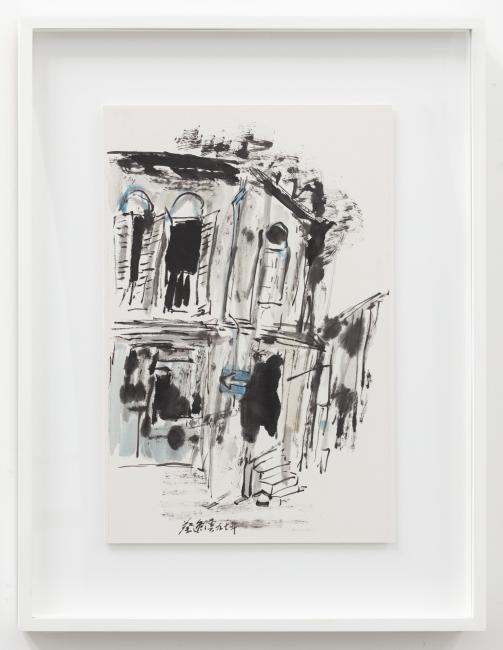Artwork Details
Corner at Ann Siang Hill
Credit Line: Gift of Artist 2006, Collection of SMU
This artwork is part of 25x25 Campus Art Tour.
Listen to the audio description of the artwork here.
Transcript:
As the title describes, this Chinese ink painting pictures a two-storey corner shophouse with a canted façade. Ek Kay uses thin delicate lines to draw in the outlines and details of the shophouse, giving the painting the wispy quality of a sketch. But rather than giving the sense of a building coming into being, here the shophouse seems to be in danger of coming undone. At the front of the shophouse, an arrow sign points backwards.
Tall large windows with arched frames and opened shutters fill the face of the second floor. On the ground floor, a three-step staircase leads up from the roadside to the main corner entrance of the shophouse. Dark black blobs of ink shroud the main corner entrance and the window panes. The same dark black blobs obscure parts of the shophouse's façade. They bring to mind mould that threatens to expand and consume the building.
As with his later works, this painting focuses on capturing the atmosphere informed by the strong sentiments of seeing once-familiar street scenes become neglected and dilapidated.
--
Chua Ek Kay (1947-2008) was one of Singapore's leading contemporary Chinese ink painters. Born in China, Chua came to Singapore with his family in the 1950s. Here he studied Chinese ink painting under Fan Chang Tien. In 1991, he was the first Chinese ink painter to win the United Overseas Bank Painting of the Year Award. He later took up formal training in contemporary art, receiving a Bachelor of Fine Arts from the University of Tasmania in 1994 and a Master of Arts (Honours) in Visual Arts from the University of Western Sydney in 1995. He was awarded the Cultural Medallion in 1999.
This artwork is from the Street Scenes Collection, a suite of 30 paintings donated by the artist in 2006 and currently housed at Lee Kong Chian School of Business. The Street Scenes Collection spans two decades of Chua's artistic practice, from 1986 to 2006, and pictures narrow alleyways, temples of worship, old shophouses and historic sites in Singapore, Kathmandu, Yogyakarta and Jiangnan. In later years, he was keener on evoking feelings rather than rendering actual physical architecture. Particularly, his depictions of Singapore city streets—from Little India to Ann Siang Hill—are suffused with feelings of melancholy as he captures history passing through the once-familiar streets he has seen grown, thrived, and waned over time.

